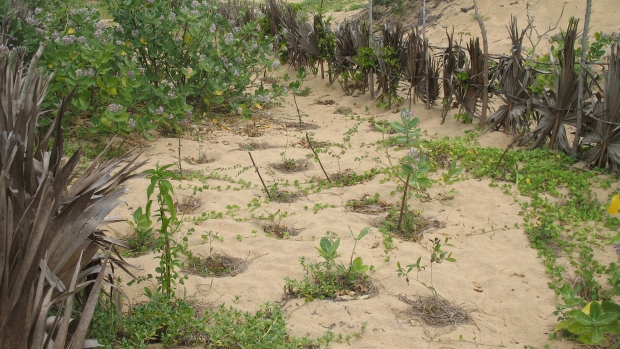Grants :: Small Grant Facilities :: Coastal green belt planting and livelihood improvement
Coastal green belt planting and livelihood improvement

Greenbelt at Panama, Sri Lanka © KEkaratne , 2009
Objectives
This project had three objectives:
- to reforest the shoreline with the help of local communities;
- to protect the reforested shore with community participation; and
- to increase the incomes of women in the community.
Background
The 2004 Indian Ocean tsunami destroyed the coastal green belt of Panama, a village in the south-eastern coastal district of Ampara. It also damaged the local fishing economy – for families which traditionally depend on men to bring in an income from fishing this caused severe hardship and deprivation. This project sought to tackle both problems by introducing a programme of participatory coastal planting, and by giving women a means to earn extra income to supplement family earnings, thereby empowering them economically.
Target beneficiaries
Residents of Panama, in particular selected women beneficiaries.
Outputs
- Creation of a 1,200 m² coastal green belt plantation.
- Construction of a well for watering the plantation.
- Delivery of two awareness programmes on coastal conservation.
- Establishment of a coastal conservation society.
- Preparation of a coastal conservation activity plan with community participation.
- Provision of support to twelve women to start self-employment in seaweed farming.
Accomplishments and challenges
The rehabilitation of the coastal green belt prevented erosion by sea and wind, thus helping to reduce environmental degradation. The community increased its awareness of environmental issues, and twelve women empowered economically through job creation started earning a supplementary income to improve the living standards of their families.
Challenges
The project was hindered by a lack of support from government agencies, and by an initial lack of awareness of environmental issues in the community that was eventually overcome by awareness programmes.
Contributions to cross-cutting themes
Gender equality
In a major change to their economic and social status, twelve women are now successfully self-employed.
Lessons Learned
The project worked best when responsibility for implementation was handed over to the community. Also, instead of using concrete posts and barbed wire to fence off the planted areas (costly and prone to rusting), the project built fences with wooden poles and Gliricidia sticks. These are more cost-effective both to set up and to maintain.
Assigning two women to look after each block of plantation proved a successful method of ensuring plants were tended because of the healthy competition it generated.
Lastly seaweed farming has proved to have strong potential as an alternative source of family income.
Project Facts
Country
Location
Panama, Sri Lanka
Topic
Duration
1st Jan 2009 to 31st Dec 2009
MFF Grant Amount
US$4,254
Implementing Partner
National Ethnic Unity Foundation (NEUF)
Police Quarters Road,
Ampara, Sri Lanka
Tel: +94 63 2223425
